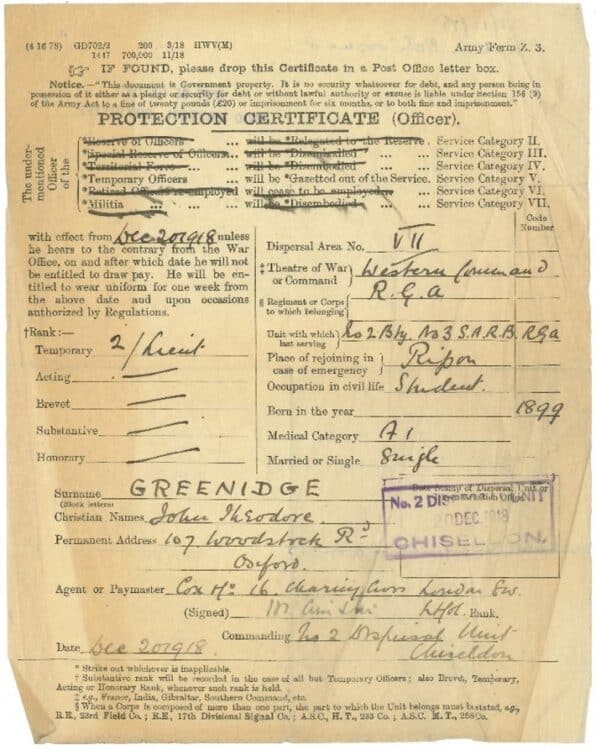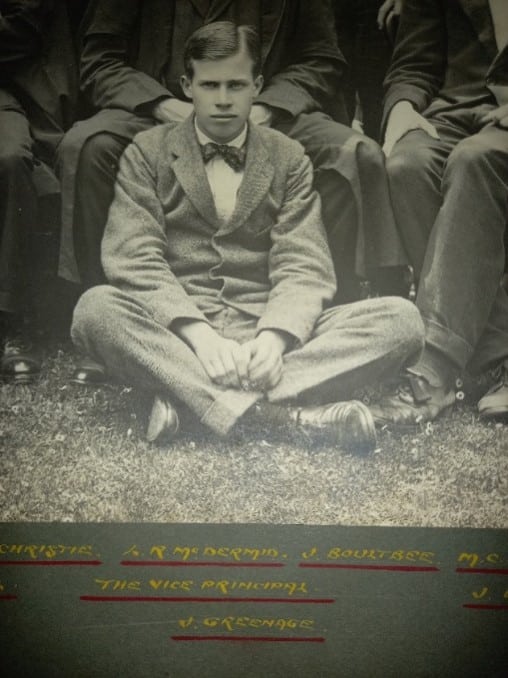Officers and Gentlemen? An Aularian ‘actor’ & architect, Evelyn Waugh and the Bride of Frankenstein
22 Jan 2024|Rob Petre
- Library, Arts & Archives

Finding the Protection Certificate for 2nd Lieutenant J T W Greenidge led me to three different archives, where I found out that this Aularian had a brief double life as a silent movie actor before becoming an architecture student.
One of the least-interesting parts of an archivist’s life is filing, but sometimes I come across something odd or interesting that makes it (almost) worthwhile.
Recently I have been filing student personal files, and I came across a file for an Aularian, John Theodore Waterman Greenidge (b.1899) who was the son of a Fellow of Hertford College, Abel Greenidge, a noted historian of Greek and Roman constitutional history. When Greenidge was left an orphan by his mother’s death in 1907 his godfather became his guardian – this was Henry Williams, better known to Aularians as ‘Burglar Bill’ and our Principal from 1913 to 1920. Greenidge matriculated at the Hall in 1917 before enlisting in the army for the final months of the war. (He features in the photograph of the Common Room for 1917, but they spell his name incorrectly in the caption underneath).
Greenidge’s file is on the slim side, containing only four bits of paper, but one of these was his Protection Certificate (see image). This was issued to servicemen as they demobilised and was designed to show that the holder was not a deserter; it could also be used to show that the holder was entitled to Unemployment Benefit. John’s war service (from December 1917) was with the Royal Garrison Artillery, in a Siege Artillery Reserve Brigade, protecting naval dockyards and other military infrastructure.
John’s file does not mention any award of a BA, so I checked with the University Archives to see if he had received a shortened war service degree. They confirmed that he passed only one paper in the Pass School, in Elements of Physics, in Trinity term 1919; he took no other papers, and so no degree was conferred.
One of the other bits of paper was a letter from Greenidge complaining that he had been charged twice for the Reunion Dinner of 1948 (a mistake that was swiftly corrected); the erroneous account calls him Fellow of the Royal Institute of British Architecture, so I contacted the archives there to see if they had any information on him.

In their files they record that when he left Teddy Hall he attended the Bartlett School of Architecture, from which he graduated in 1924, taking the RIBA Professional Practice paper in 1925. His architectural practice was based in Kettering but his designs were not focussed solely on Northamptonshire; among his works he designed theatre decorations in Paris, he designed buildings for the Dragon School here in Oxford and in 1935 he created the murals for the roof garden of 61 Cadogan Place, London. (This block of mansion flats is listed, but the listing does not mention the murals – I wonder if they are still there).
Contact with the University Archives drew my attention to John’s brother, Terence Lucy Greenidge; one of the Assistant Keepers there suggested that I google him, and I found that he was a friend of Evelyn Waugh from their time together at Hertford College. The brothers, Waugh and a Rugby friend called John Sutro made a silent film called The Scarlet Woman: an ecclesiastical melodrama, in which a scheming Cardinal tries to use the Dean of Balliol to convert Britain back to Roman Catholicism by seducing the Prince of Wales, who is saved by falling in love with a stoutly Protestant cabaret actress. The real-life Dean of Balliol was the man who closed down the Hypocrites Club of which Waugh and Terence Greenidge were members. (Waugh seems to have been fond of this sort of literary revenge. He fell out with his Dean at Hertford, Charles Cruttwell, and his novels are peppered with appalling men with the surname Cruttwell. One of Waugh’s biographers felt that this bullying caused Cruttwell’s mental health to break down, and he died in a neurological hospital in Bristol).
In The Scarlet Woman our man John Greenidge played the Prince and Elsa Lanchester played the actress. She went on later to find fame in Hollywood as The Bride of Frankenstein. The Waugh film is perhaps not top quality, splicing in what looks like tourist footage from Rome (which John had visited as an architectural student) with scenes shot in Hampstead. If you are interested in British silent films with slightly amateurish production values and performances of a naïve (aka hammy) nature, the film can be found on the BFI Player from the British Film Institute. (Thanks to the staff of the BFI Player for their help in accessing this).
I am not sure which is the bigger surprise, the fact that the film has survived or the fact that John Sutro went on to a successful career in films as a producer and production manager. And I wonder what did Waugh, who converted to Catholicism in 1930, make of his youthful, very anti-Catholic folly?
Category: Library, Arts & Archives
Author

Rob
Petre
Rob is the College Archivist. His role is to preserve the documentary heritage of St Edmund Hall and to try and answer questions on any aspect of the Hall’s history with reference to our archive collection.